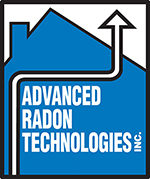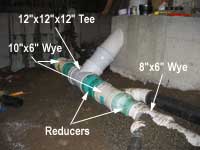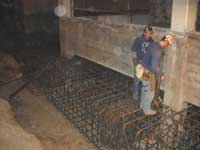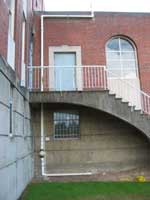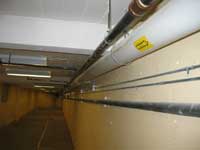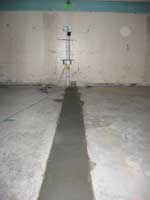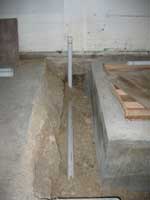Case Study:
The McChord Air Force Mission Support Center
Contact Us For A Free Quote
McChord Air Force Mission Support Center
The original specifications for this building called for a minimum of 50 and as many as 100, residential type systems to be installed (like the one seen here, installed by a previous contractor) around the exterior of the building.
The pictures that follow show the unique aspects of installing a commercial radon system in this type of structure.
1¼” steel rebar and 5/8″ steel rebar were added to the footings for seismic upgrade before the concrete was poured. The 1¼” rebar was tied to the existing foundation. With the large amount of rebar in the footings, it is not feasible to go through the footings with the radon pipe.
This footing is 10′ across and 6′ deep. The soil underneath the footings is highly compacted. The footings in this building divide the foundation into sections. Each section must be depressurized separately.
A 12″ thick sheer wall will sit on top of the footing and extend through all four floors of the building to the bottom of the roof. This wall ties all the horizontal and vertical foundation components together.
As can be seen in this shot from the east side of the riser, the tee ties these three runs of 6″ ADS double wall, non-perforated pipe to the 12″ riser (the pipe was lightly perforated to facilitate condensate drainage).
This view is from the west side of a 12″ riser. The tee was manufactured with a 12″ x 12″ x 12″ tee, two 10″ x 6″ wyes, and two 8″ x 6″ wyes. The wyes were used to minimize pressure drop.
Floor supports were needed for the 12″ risers. Running through 4 floors, the riser weighed several hundred pounds.
Portions of the existing slab were to remain intact. In these areas, the floor was saw cut and trenched for the radon pipe (see picture, lower-left). Here, our patented tester was placed on a 4″ line after the cement was repoured (see picture, lower-right). We did this to test for air flow and negative pressure across the entire slab.
This 6″ run is routed down a long storage area.
This 6″ run goes below-grade and through a 10″ thick wall.
We had to core drill a 5″ hole through a 10″ thick wall. The ladder seen in the picture is 7 feet.
This is a 6″ 3034 PVC riser in the crawlspace with Geotech cloth to minimize asbestos transfer.
Two 4″ double wall runs join to the 6″ double wall main line. Both are non perforated pipe that we drilled holes in to evenly distribute the negative pressure extension.
Here the 10 mil. plastic is seen over the 6″ x 6″ x 6″ 3034 tee and 6″ riser.
Here is a portion of the 10,000 sqft of 10 mil plastic that was laid during Phase 1 of the project. In all, 50,000 sqft of 10 mil plastic will be laid the crawlspace.
2″ of CDF concrete was sprayed over the Visqueen in the crawlspace to completely encapsulate the asbestos.
Advanced Radon Technologies:
Radon Mitigation Services
Services
Real Estate Services
